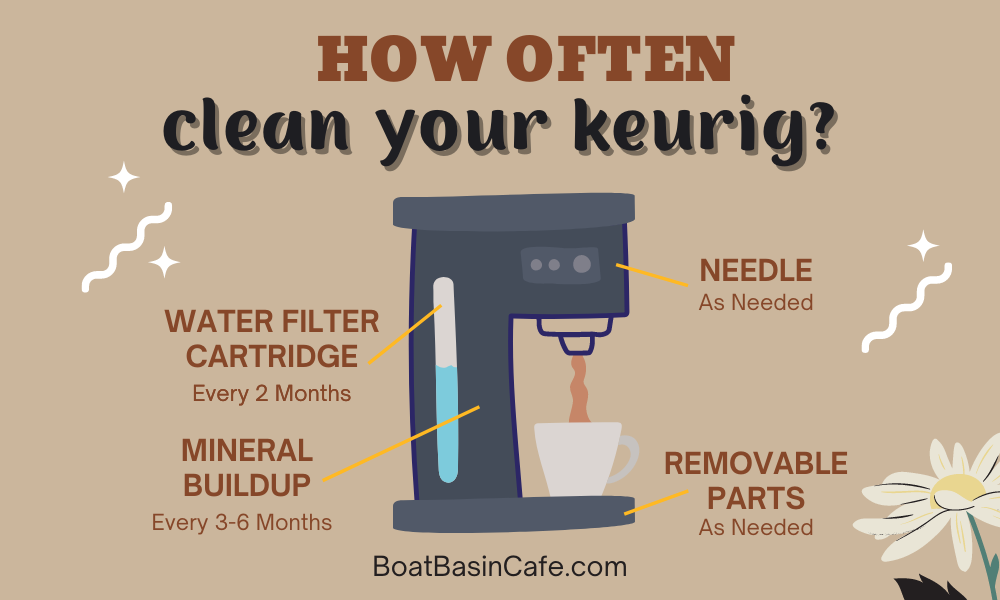If you’re like me, feeling frustrated over wrestling with your cherished morning companion—a Keurig unwilling to descale—you are in the right place. Time to explore the ins and outs of Keurig maintenance and Keurig troubleshooting. By learning to pinpoint and address these issues, you’ll not only enjoy your favorite brew at its fullest but also prolong the lifespan of your Keurig.

The Importance of Descaling Your Keurig
Let’s tackle the question that might be nagging at you: Why bother with descaling? The key to this lies in the type of water you feed your Keurig. Unless it’s distilled (which isn’t common due to its lacklustre taste), other kinds of water contain minerals—mainly calcium and magnesium. Over time, these can accumulate to form deposits commonly termed ‘lime scale’.
Now, the slow but persistent build-up of these hard, rock-like minerals within the internals of your coffee maker forms a barrier that causes it to labor double time every brewing cycle. Gradually, this problem could escalate to slower brewing times, increased noise levels, inconsistent water flow, and even a decreased lifespan of your appliance.
Surefire Signs That Your Keurig Needs A Descaling Operation

So, how do you tell when your beloved Keurig is crying out for descaling? Here are some clear signs you should monitor:
- Brewing time starts feeling like forever, especially compared to previous speedy runs.
- The hum of the machine during brewing cycles becomes noticeably louder or differs in pitch.
- There is a noticeable slow-down in water flow, or your brew doesn’t fill your cup quite as much.
If your Keurig is exhibiting any or all of these symptoms, it’s the wake-up call to pronto embark on the descaling operation. Fret not, for this might seem a daunting chore, but it’s a simple, straightforward job with the right parts and instructions.
Step-by-Step Guide: How to Effectively Descaling Keurig
| Steps for Effective Keurig Descaling | Details |
|---|---|
| Step 1: Equipment Checklist | Gather required materials: descaling solution, fresh water, ceramic mug, access to sink and clean, dry cloth. |
| Step 2: Setting the Stage | Ensure the machine is off and cool. Remove the water reservoir and K-cup holder if present. |
| Step 3: Descaling Solution Selection | Follow official Keurig descaling solution or use a homemade one like mixed white vinegar and water in equal parts. |
| Step 4: Kicking Off the Descaling Cycle | Place the mug, start the descaling cycle and continue with cycles till the tank is empty. |
| Step 5: Rinse, Wipe, and Cap It Off | Rinse the reservoir with fresh water, run brewing cycles till empty again. Wipe the exterior clean. |
Step 1: Equipment Checklist
To begin, gather the following essentials: a Keurig descaling solution (or a DIY one like white vinegar), fresh water, a ceramic mug, access to a sink, and a clean, dry cloth.
Step 2: Setting the Stage
Before anything else, make sure your machine is turned off and cooled. Prioritize your own safety from any scalding steam or hot drips. At this stage, remove and empty the water reservoir. If your machine harbors a K-cup holder, take this out too.
Step 3: Descaling Solution Selection
As an alternative to the official Keurig descaling solution, white vinegar mixed with equal parts of water could serve as a safe and inexpensive homemade option. For those going with vinegar, remember to follow up with a cycle using only water to flush out any lingering trace of vinegar.
Step 4: Kicking Off the Descaling Cycle
With the descaling solution ready, it’s time to invite your Keurig to the party. Plant your ceramic mug on the tray and start the descaling cycle. Exercise some patience and let the brewer complete its magic dance. It isn’t uncommon to encounter issues like Keurig not brewing after descaling. Following through with the cycles till the tank is drained should handle such hiccups.
Step 5: Rinse, Wipe, and Cap It Off
Once your Keurig has performed its full descaling performance, be sure to fill up the reservoir with fresh water and continue with brewing cycles until the tank is once again empty. This critical rinsing step ensures no trace of descaling solution remains. After this, use a clean cloth dampened with warm water to clean the exterior.
Congratulations! You’ve performed a successful descaling operation on your Keurig.
Few Handy Tips for Efficient Keurig Descaling
To ensure you get the most out of your descaling efforts, here are some extra tips:
- Emphasize on using filtered water instead of tap water in your Keurig’s reservoir, which can help prevent rapid scale build-up.
- Regularly check and clean the needles, which can sometimes get clogged with coffee grounds and slow the water flow.
- Keep a regular schedule for Keurig descaling, ideally every three to six months, to prevent heavy mineral deposits.
FAQs
How often should I descale my Keurig?
Target for once every three to six months, according to water quality and your coffee consumption frequency.
Can vinegar replace descaling solution?
Absolutely! Vinegar is a proven alternative, but remember to run a pure water cycle after to cancel any residual vinegar aroma.
Are there other homemade Keurig descaling methods?
Yes, other options include diluted citric acid or a mix of baking soda and water.
Will descaling help with brewing issues besides slow processing?
Yes, descaling helps solve most problems stemming from mineral build-up, including irregular water flow and strange sounds.
Can I descale a Keurig model without a descaling cycle feature?
Yes, you can. Use the regular brewing option to run the descaling solution, repeating several times for thorough internal cleaning.
Conclusion
In conclusion, maintaining a regular descaling routine for your Keurig not only ensures efficient functioning but also steps up your coffee’s taste and aroma. Let your bitter descaling battles be a thing of the past—equip yourself with the tips here to enhance your coffee experience and your Keurig’s lifespan. So, go on and enjoy the satisfaction of a perfect brew from your well-cared-for Keurig!